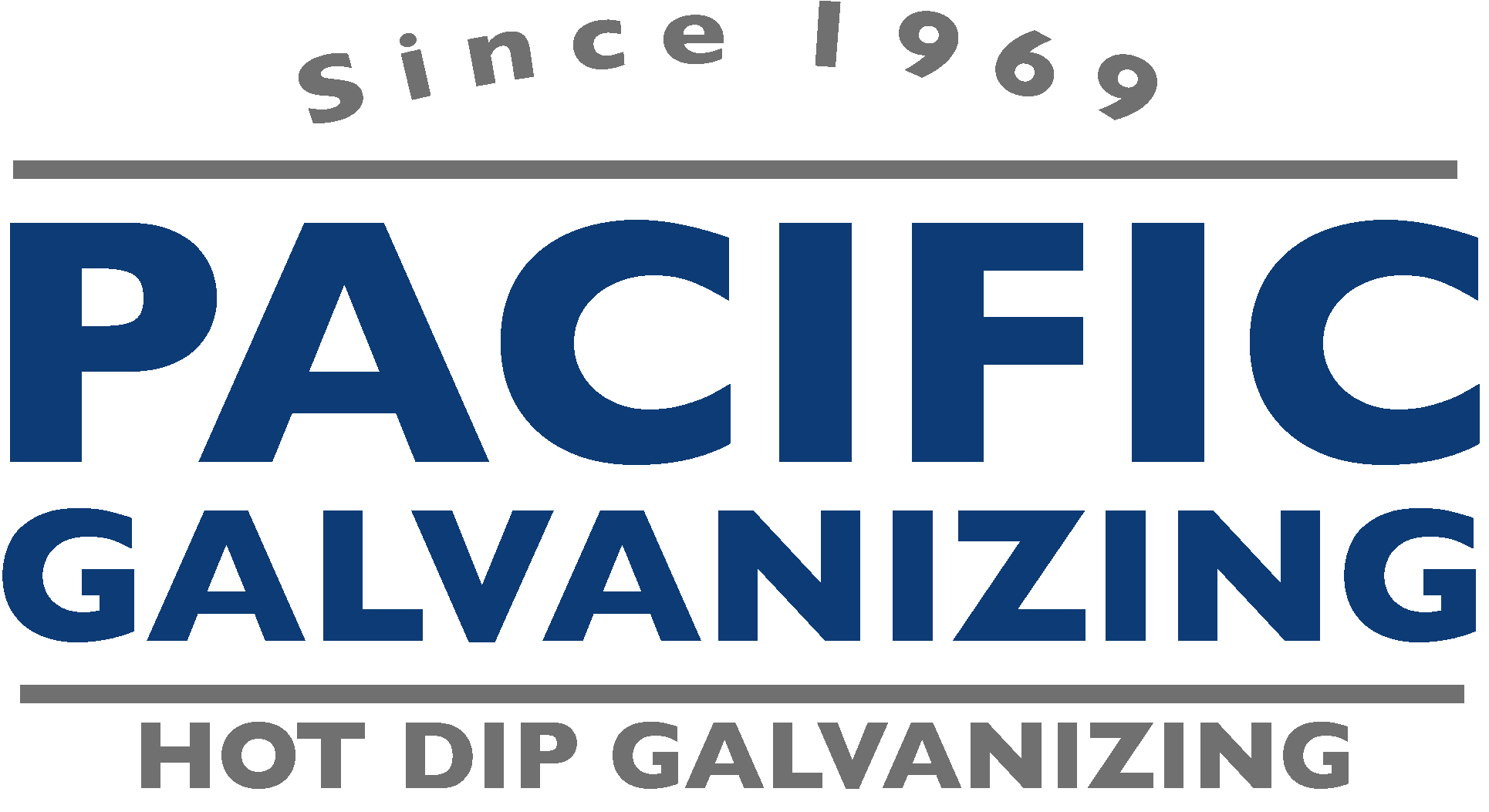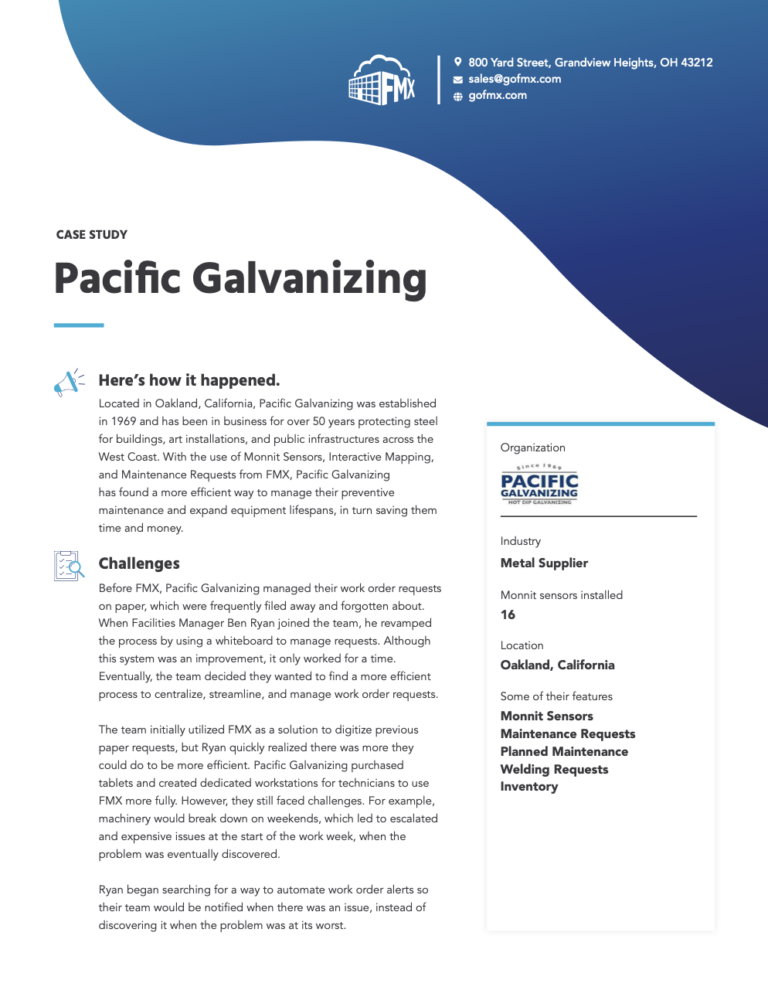
Here’s how it happened.
Located in Oakland, California, Pacific Galvanizing was established in 1969 and has been in business for over 50 years protecting steel for buildings, art installations, and public infrastructures across the West Coast. With the use of Monnit Sensors, Interactive Mapping, and Maintenance Requests from FMX, Pacific Galvanizing has found a more efficient way to manage their preventive maintenance and expand equipment lifespans, in turn saving them time and money.
Challenges
Before FMX, Pacific Galvanizing managed their work order requests on paper, which were frequently filed away and forgotten about. When Facilities Manager Ben Ryan joined the team, he revamped the process by using a whiteboard to manage requests. Although this system was an improvement, it only worked for a time. Eventually, the team decided they wanted to find a more efficient process to centralize, streamline, and manage work order requests.
The team initially utilized FMX as a solution to digitize previous paper requests, but Ryan quickly realized there was more they could do to be more efficient. Pacific Galvanizing purchased tablets and created dedicated workstations for technicians to use FMX more fully. However, they still faced challenges. For example, machinery would break down on weekends, which led to escalated and expensive issues at the start of the work week, when the problem was eventually discovered.
Ryan began searching for a way to automate work order alerts so their team would be notified when there was an issue, instead of discovering it when the problem was at its worst.
FMX: The Solution
The solution was to integrate Monnit Sensors with FMX. In the beginning, Pacific Galvanizing invested in three of these sensors, which they found to be cheaper than other solutions on the market. From there, Ryan was able to scale the program up to the 16 sensors they use today, with plans to continue expanding.
“Maybe I don’t need a sensor on every piece of equipment. Maybe it’s the most expensive equipment, or maybe it’s the equipment that breaks down the most. You can put a lot of controls in place to make sure that you don’t ever have a failure when there’s no humans around watching it.”
With the use of Monnit Sensors and FMX, the maintenance team at Pacific Galvanizing was able to shift out reactive, emergency breakdowns and avoid costly repairs. Previously, they would discover an issue when the equipment was broken down or employees would continue using equipment past the threshold of when maintenance was required. Both of these scenarios led to time-consuming and expensive repairs and replacements. With Monnit Sensors, if equipment reaches the set parameters, a work order request is created in FMX and an alert is immediately sent to the maintenance team.
Paired with Interactive Mapping, the maintenance team is able to find equipment quicker and differentiate more easily between equipment items with similar names or that are physically stacked together.
Results & Benefits
This created a more efficient workflow for the team at Pacific Galvanizing. Ryan says, “Because I get the alerts on my phone, I could be out and about doing something else, and all of a sudden, my phone will alert and I’ll check it. I can pull up the security footage on my phone and go back to the exact timestamp it alerted and see what they did with it. And then, I can instantly know if I need to send a technician out to check it or not.”
The use of sensors has also made employees use equipment more carefully, knowing that the sensors can send work orders without the employees’ input. Ryan has installed various sensors, including the following:
- Temperature Sensors
- G-Force Sensors
- Vibration Sensors
- Pulse Sensors
By using Interactive Mapping, they’re able to use maps to provide contractors or inspectors with a visual of equipment locations. Recently, an inspector used their maps to recertify fire extinguishers and was able to use the map to locate all of the fire extinguishers at the plant. Additionally, when equipment is retired, they are able to note it as such on the map and add any new equipment replacements to the map. This ensures all their historical data is easily accessible, and their map is updated for the maintenance team when they go to resolve a maintenance issue.
With these tools, Ryan is using the data to shift from basic time-based maintenance to condition-based maintenance. Using the data between FMX and Monnit, they are able to view repair and usage trends over days, weeks, and months to understand the cadence of maintenance over a typical year. They can also use this data to begin predicting and anticipating when equipment might fail or need maintenance, which allows them to better plan out their budget and capital investments for the year.
Ryan says, “I want to replace it, you know, two weeks before the design fails, and then it’ll never fail. And we’d love to get that good with knowing when our electric motors get to a certain point of vibration, we know we have to send it back in and have it rebalanced before it fails.”
Further steps
Take a product tour
Speak with a product expert to see FMX for yourself
Get a custom quote
Get a pricing estimate for your organization's unique needs
Learn more about how manufacturing can use FMX
Optimize your manufacturing maintenance management system with streamlined CMMS software
